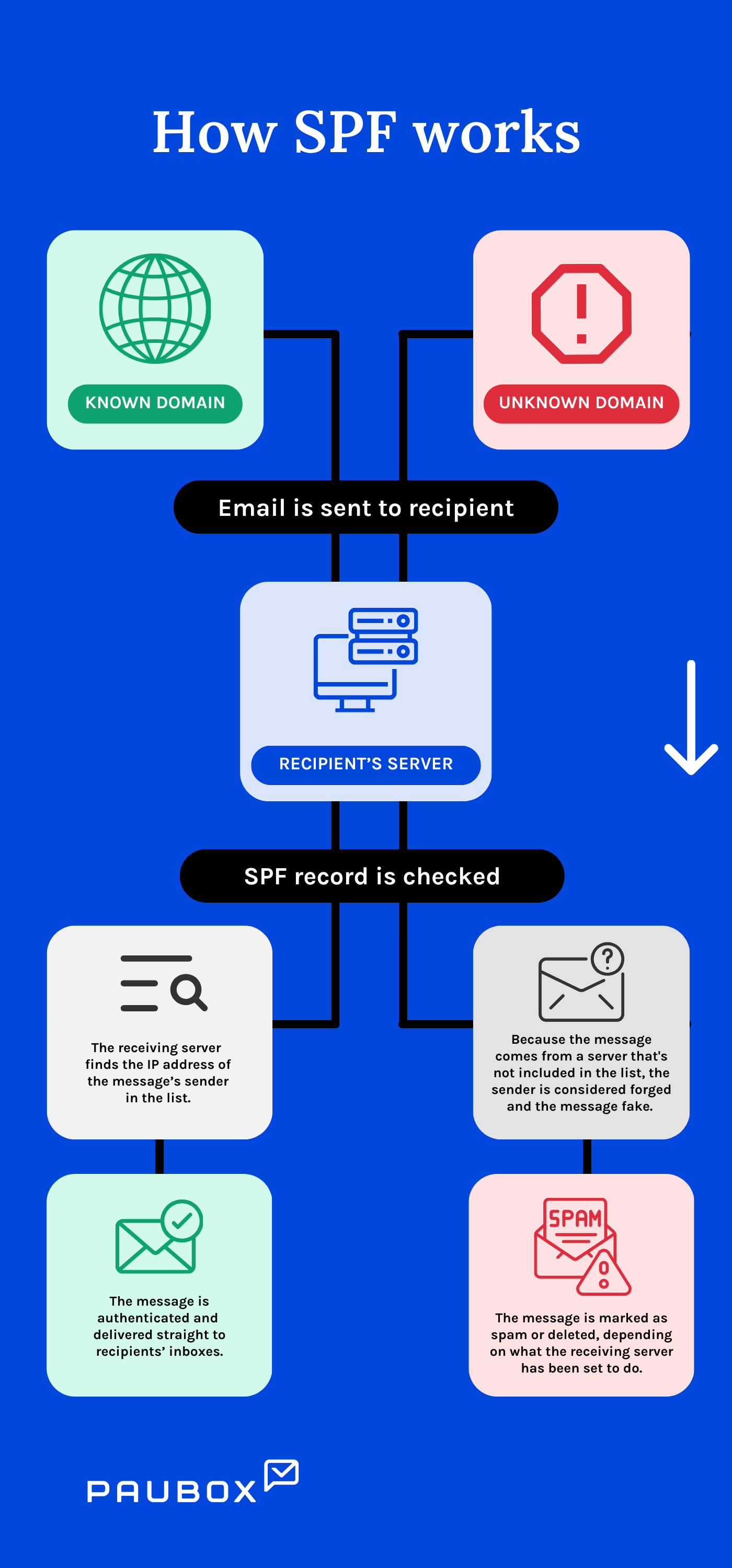
Sender Policy Framework (SPF) is an email authentication method that helps identify mail servers allowed to send email for a given domain. By using SPF, ISPs can identify emails from spoofers, scammers, and phishers as they try to send malicious emails from a domain that belongs to a company or brand.
How does SPF work?
To take advantage of SPF, you publish an SPF record in the Domain Name System (DNS). The record is a list of all the IP addresses allowed to send email on behalf of the domain.
The SPF mechanism uses the domain in the return-path address to identify the SPF record. When delivering an email to a receiving server, if the sender is listed as one of the allowed senders on that particular domain's list, this establishes a connection between their email and said domain. If not, then the server continues processing the email as usual without this link, as any number of things could be going on.

Limitations of SPF
According to Rajendra Mishra, digital marketing expert at MAG, “The “From” header is not validated by SPF. This header appears in most clients as the message’s sender.” Instead, SPF uses the "envelope from" to determine a sending domain.
Additionally, forwarding can cause issues for SPF as it leads to an alteration of senders and mismatches with destination checks.
Sources of SPF
The SPF records are typically published as TXT records in the DNS for a domain. These TXT records contain the SPF policy information that specifies which mail servers are authorized to send emails on behalf of the domain. Here are the common sources of SPF information:
- Domain's DNS records: The primary and authoritative source of SPF information is the DNS records of the domain itself. Domain owners can create and manage SPF records in their DNS zone file.
- SPF Record Syntax: Domain owners can manually create SPF records using this syntax, specifying the mechanisms and qualifiers that define their SPF policy.
- Third-party SPF tools: There are various online tools and SPF wizards available that can help domain owners generate SPF records based on their specific mail server configuration and requirements.
- Email service providers (ESPs): Many email service providers offer built-in support for SPF authentication and may provide guidance or assistance in configuring SPF records for their customers' domains.
- Documentation and guidelines: Domain owners can refer to official documentation and guidelines provided by standards organizations, industry groups, or email service providers for best practices and recommendations on SPF implementation.
- Consultation with IT professionals: In cases where SPF configuration may be complex or require specialized expertise, domain owners may seek assistance from IT professionals, system administrators, or email security specialists. These professionals can provide customized SPF recommendations based on the organization's email infrastructure and security requirements.
How SPF enhances HIPAA compliant email communication
The Health Insurance Portability and Accountability Act (HIPAA) establishes standards and regulations for protecting sensitive patient health information. HIPAA’s Security Rule safeguards electronic protected health information (ePHI) to ensure its confidentiality, integrity, and availability. While the HIPAA Security Rule doesn't explicitly mandate the use of specific email security protocols like SPF, implementing SPF can contribute to HIPAA compliance efforts in several ways:
- Prevention of unauthorized disclosure: By specifying which mail servers are authorized to send emails, SPF reduces the risk of unauthorized disclosure of PHI through spoofed or phishing emails.
- Mitigation of email spoofing: By examining the SPF records found in DNS, SPF verifies the legitimacy of the sender domain and bolsters email spoofing prevention measures while guarding against unauthorized access to PHI.
- Protection against email fraud: SPF helps protect against email fraud by ensuring that only authorized mail servers can send emails using the organization's domain.
- Enhanced data security: By reducing the risk of unauthorized access to PHI through email-based attacks, SPF contributes to safeguarding patient confidentiality, integrity, and availability, which are key components of HIPAA compliance.
- Demonstration of due diligence: To comply with HIPAA, covered entities and business associates must put in place appropriate measures to safeguard PHI. By implementing SPF protocols, they exhibit adequate care in securing email communications and preventing potential hazards like phishing or spoofing attacks.
See also: HIPAA Compliant Email: The Definitive Guide
Tips and best practices
- Regularly review and update SPF records: Ensure that SPF records are regularly reviewed and updated to reflect changes in your organization's email infrastructure, such as adding or removing mail servers or IP addresses.
- Consider third-party senders: If your organization uses third-party email service providers or marketing platforms to send emails on behalf of your domain, ensure they are included in your SPF records.
- Use SPF testing tools: Regularly test SPF records using SPF testing tools or online validators to ensure they are correctly configured and interpreted by receiving mail servers.
- Implement SPF with DKIM and DMARC: Combine SPF with DomainKeys Identified Mail (DKIM) and Domain-based Message Authentication, Reporting, and Conformance (DMARC) for comprehensive email authentication and protection against email spoofing and phishing attacks.
- Monitor SPF failures: Monitor SPF failure reports and logs to identify unauthorized email senders, potential spoofing attempts, or misconfigurations in your SPF records.
- Educate email users: Educate email users within your organization about SPF and how it helps protect against email-based threats, including phishing and spoofing.
- Regular security audits: Conduct regular security audits and assessments of your organization's email infrastructure, including SPF configuration, to identify vulnerabilities and ensure compliance with email security best practices.
Read more: How to set up DKIM and SPF records
FAQs
How do I create an SPF record?
To create an SPF record, you need to add a TXT record to your domain's DNS zone file. This TXT record contains the SPF policy for your domain, including the list of authorized sending sources. You can manually create SPF records or use online SPF wizards and tools for guidance.
What happens if an email fails SPF?
If an email fails SPF (i.e., the sending mail server's IP address is not authorized according to the SPF record), the recipient's mail server may mark the email as spam, quarantine it, or reject it outright, depending on the recipient's SPF policy.
Why is SPF important?
SPF helps prevent email spoofing and phishing attacks by verifying the authenticity of the sender's domain. It enhances email security, reduces the risk of unauthorized use of domain names in emails, and improves the deliverability of legitimate emails.
Subscribe to Paubox Weekly
Every Friday we'll bring you the most important news from Paubox. Our aim is to make you smarter, faster.



